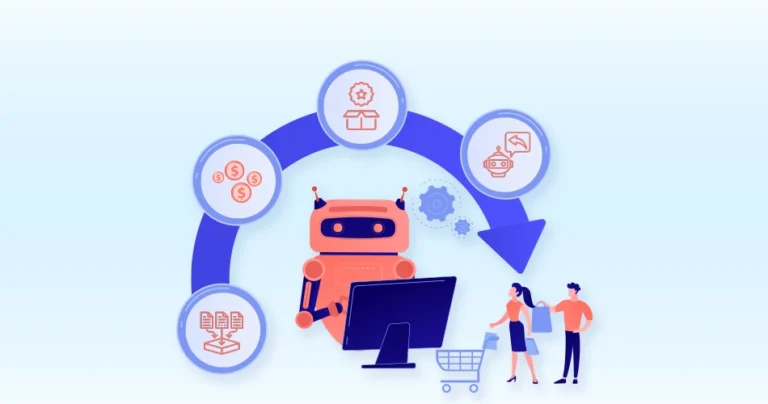Artificial Intelligence has rapidly evolved from a futuristic concept to the cornerstone of modern eCommerce. It can analyze vast amounts of data and identify intricate patterns to deliver personalized eCommerce experiences.
With AI, you can better understand the customer behavior, preferences, and purchase patterns. That will help offer tailored product recommendations and site UX and drive targeted marketing campaigns. The result? Increased customer satisfaction, higher conversion rates, and stronger brand loyalty.
So, in this blog, we’ll explain how the eCommerce development experts use AI for personalization.
What is Personalization in eCommerce?
Personalization in eCommerce is the practice of tailoring the online shopping experience to individual customers or specific customer segments. It involves using data to understand customer preferences, behavior, and purchase history to deliver highly relevant product recommendations, content, and offers.
By creating a personalized experience, businesses can enhance customer satisfaction, build stronger relationships, and ultimately drive sales. Essentially, personalization is about treating each customer like a VIP by providing them with a unique and engaging shopping journey.
Benefits of Personalization in eCommerce
Personalization is not just a buzzword; it’s a strategic imperative for eCommerce success. By tailoring the shopping experience to individual customers, businesses can reap numerous benefits:
- Increased Conversions: Personalized product recommendations, targeted offers, and relevant content guide customers towards desired actions, boosting conversion rates.
- Improved Customer Experience: When customers feel understood and valued, they are more likely to have a positive shopping experience, leading to increased satisfaction and loyalty.
- Higher Average Order Value (AOV): By showcasing complementary products or upselling relevant items, personalization can encourage customers to spend more per order.
- Enhanced Customer Loyalty: A personalized experience fosters a deeper connection with customers, making them more likely to return and become repeat buyers.
- Deeper Customer Understanding: Through personalization, businesses gain valuable insights into customer preferences, behaviors, and needs, enabling data-driven decision-making.
- Competitive Advantage: Personalization sets businesses apart from competitors, creating a unique and memorable shopping experience.
By harnessing the power of personalization, eCommerce businesses can drive growth, build customer relationships, and achieve long-term success.
Now that you understand why the eCommerce development services focus on personalization, let’s look at how they use AI for it.
How to Use AI for Personalization in eCommerce?
AI can be an excellent tool in eCommerce personalization. From dynamic product recommendations to personalized pricing and email marketing, AI offers a multitude of opportunities of personalizing the eCommerce website.
Data Collection and Analysis
AI personalization in eCommerce is driven by data (in copious amounts). Collecting and analyzing the right data is crucial for understanding customer behavior and preferences. As apparent, there are two parts of this step.
Data Collection
The process of gathering relevant information about customers and their interactions with your business. This includes:
- Customer Demographics: Basic information like age, gender, location, and income level.
- Purchase History: Detailed records of products purchased, quantities, prices, and dates.
- Browsing Behavior: Tracking pages visited, time spent on each page, products viewed, and abandoned carts.
- Customer Interactions: Recording interactions with customer support, live chat, or social media.
- Social Media Data: Analyzing likes, shares, comments, and other social interactions related to your brand.
- Marketing Data: Tracking the performance of eCommerce marketing campaigns, including email open rates, click-through rates, and conversions.
Data Analysis
Transforming raw data into actionable insights. This involves:
- Data Cleaning: Ensuring data accuracy, consistency, and completeness by removing errors, duplicates, and inconsistencies.
- Customer segmentation: Grouping customers into specific segments based on shared characteristics (e.g., demographics, purchase behavior, preferences).
- Customer Profiling: Creating detailed buyer personas or segments, highlighting their preferences, behaviors, and purchase patterns.
- Predictive Modeling: Using AI algorithms to forecast future customer behavior based on historical data.
- Pattern Recognition: Identifying trends, correlations, and patterns within the data to uncover valuable insights.
- Customer Lifetime Value (CLTV) Analysis: Assessing the potential long-term value of each customer.
Make sure you maintain the quality and privacy of data throughout the process. That will help deliver the best results.
Personalized Product Recommendations
One of the key parts of personalization in eCommerce is product recommendations. By suggesting relevant items, businesses can increase sales, improve customer satisfaction, and foster loyalty.
Common types of AI-powered recommendations are:
- Product-based recommendations: Suggesting items similar to those the customer has viewed or purchased.
- User-based recommendations: Recommending products purchased by similar customers.
- Content-based recommendations: Suggesting products with similar attributes or features.
- Cross-selling: Recommending complementary products to increase order value.
- Upselling: Recommending higher-priced or premium versions of products.
Now, let’s see how the product recommendation process goes:
Step 1: Data Collection: Gather comprehensive data on customers, including demographics, purchase history, browsing behavior, and search history. Collect detailed product information, such as categories, attributes, descriptions, and images.
Step 2: Data Preprocessing: Cleanse the data to remove inconsistencies or errors. Transform data into a suitable format for analysis (like numerical or categorical).
Step 3: Select the Recommendation Algorithm: Choose an appropriate recommendation algorithm based on the available data and desired outcomes. Common algorithms include:
- Collaborative filtering: Recommends items based on similarities between users.
- Content-based filtering: Recommends items based on product attributes and user preferences.
- Hybrid: Combines collaborative and content-based filtering for improved accuracy.
Step 4: Model Training: Feed the prepared data into the chosen algorithm to build a recommendation model. The model learns patterns and relationships between users, items, and preferences.
Step 5: Recommendation Generation: Use the trained model to generate personalized product recommendations for individual users. Recommendations can be displayed in various formats, such as product lists, carousels, or pop-ups.
Step 6: Evaluation and Refinement: Continuously monitor the performance of the recommendation system. Measure key eCommerce metrics like click-through rates, conversion rates, and average order value. Refine the recommendation algorithm and data based on performance analysis.
Product recommendations are effective for driving customer engagement and sales.
Dynamic Pricing and Promotions
Dynamic pricing and promotions involve adjusting product prices and offers in real-time based on various factors to maximize revenue and optimize sales. AI plays a crucial role in this process by analyzing vast amounts of data to inform pricing decisions.
Key considerations for dynamic pricing and promotions include:
- Price elasticity: Understanding how price changes affect demand.
- Customer segmentation: Identifying different customer segments with varying price sensitivities.
- Competitor analysis: Monitoring competitor pricing and adjusting accordingly.
- Inventory levels: Balancing pricing with inventory management.
- Ethical considerations: Ensuring fair pricing practices and avoiding price gouging.
Here’s how you implement dynamic pricing and promotions:
Step 1: Data Collection: Gather data on product information, customer behavior, competitor pricing, inventory levels, demand fluctuations, and external factors like economic indicators.
Step 2: Data Analysis: Utilize AI algorithms to analyze the collected data and identify patterns and trends. Identify factors influencing price elasticity, customer segmentation, and demand forecasting.
Step 3: Pricing Model Development: Create a pricing model that incorporates the identified factors. Determine pricing rules and strategies, such as price discrimination, time-based pricing, or competitor-based pricing.
Step 4: Price Optimization: Use AI to optimize prices in real-time based on the pricing model and current market conditions. Consider factors like inventory levels, demand, competition, and customer segmentation.
Step 5: Promotion Optimization: Analyze customer behavior and preferences to create targeted promotions. Determine the optimal timing, discount levels, and promotion channels for maximum impact.
Use A/B Testing to experiment with different pricing and promotion strategies to measure their effectiveness. Continuously monitor market conditions and customer behavior and make necessary adjustments to pricing and promotion strategies.
Personalized Content Delivery
Personalized content delivery involves tailoring content or specific customer segments based on customers’ preferences, behavior, and interests. This enhances the customer experience, increases engagement, and drives conversions.
What to do?
- Product Descriptions: Dynamically generate product descriptions that highlight specific features relevant to the individual customer. For example, emphasizing eco-friendliness for environmentally conscious shoppers or focusing on performance metrics for athletes.
- Email Marketing: Send highly targeted email campaigns with personalized product recommendations, exclusive offers, and content tailored to each recipient’s interests. For instance, a fashion retailer might send emails featuring trendy styles to younger customers or classic designs to older customers.
- Website Content: Display personalized product recommendations, blog articles, and banners based on the customer’s browsing history and purchase behavior. The website can recommend complementary products to items a customer has viewed. Or maybe, suggest blog posts related to their recent purchases.
- Social Media Content: Curate social media feeds based on user preferences and behavior, showcasing products or content that aligns with their interests. For instance, a sports apparel brand can display content featuring professional athletes for sports enthusiasts.
Personalized content will increase the engagement and customer experience, resulting in a boost in conversion rates.
Chatbots and Virtual Assistants
Chatbots and virtual assistants have become integral components of modern eCommerce. These AI-powered tools offer a new level of customer interaction and support. While often used interchangeably, they have distinct characteristics and capabilities.
Chatbots
- Definition: Chatbots are computer programs designed to simulate human conversation through text or voice interactions.
- Purpose: Implementing chatbots is primarily focused on handling specific tasks or providing information.
- Capabilities:
- Answering frequently asked questions (FAQs)
- Providing product information
- Handling customer inquiries and complaints
- Processing orders and returns
- Offering basic customer support
- Examples:
- eCommerce websites offering product recommendations or order tracking
- Customer support platforms providing initial assistance
- Social media platforms offering automated responses
Virtual Assistants
- Definition: Virtual assistants are more advanced AI-powered systems capable of understanding and responding to complex queries, performing tasks, and learning from user interactions.
- Purpose: Offering comprehensive assistance beyond basic information or task completion.
- Capabilities:
- Scheduling appointments
- Setting reminders
- Controlling smart home devices
- Providing personalized recommendations
- Offering proactive assistance based on user behavior
- Examples:
- Apple’s Siri, Amazon’s Alexa, Google Assistant
- Business-specific virtual assistants for customer support or sales
These two programs are a key part of the eCommerce marketing automation approach. They can help enhance customer satisfaction and drive business growth.
Needless to say, there are other ways to personalize your eCommerce website using AI. If you need some customized solutions on your eStore, we suggest you consult with our eCommerce development company.
To Summarize
AI personalization has been revolutionary in eCommerce. You can benefit from personalized product recommendations, dynamic pricing, intelligent chatbots, and more. These can help deliver exceptional value and build lasting customer relationships.
While implementing AI personalization requires careful planning and data management, the potential rewards are immense. By understanding customer behavior, preferences, and purchase history, businesses can optimize marketing efforts, increase sales, and foster loyalty.
To fully realize the benefits of AI personalization in eCommerce, we suggest you talk to our experts today!
FAQs on AI Personalization for eCommerce
Q1. What is AI personalization in eCommerce?
AI personalization in eCommerce involves using artificial intelligence to tailor the shopping experience for individual customers based on their preferences, behavior, and purchase history. This includes personalized product recommendations, targeted marketing, and customized content.
Q2. What AI technologies are used for personalization?
AI technologies commonly used for personalization include machine learning, natural language processing, and deep learning.
Q3. How will AI personalization change the shopping experience?
AI personalization will create more immersive and engaging shopping experiences, with a focus on individual preferences and needs.





